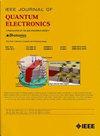Control of Polaritonic Coupler Using Optical Stark Effect in 2D Hybrid Organic-Inorganic Perovskite Microcavity
IF 2.1
3区 工程技术
Q3 ENGINEERING, ELECTRICAL & ELECTRONIC
引用次数: 0
Abstract
This research delves into the innovative application of the optical Stark effect in dynamically guiding polaritons through a Y-shaped potential, forming a polaritonic coupler within a 2D hybrid organic-inorganic perovskite microcavity. The study explores the characteristics of the 2D perovskite, focusing on harnessing the optical Stark-induced energy shift in the polariton branches. The polaritonic coupler, which has a single input and two divergent outputs, is subjected to an external optical Stark pulse, dynamically guiding polaritons between the input and outputs. The research focuses on examining the controllability of the polaritonic coupler through the polariton coupling ratio, highlighting the regulatory role played by the optical Stark effect in this dynamic process. In-depth analyses of the spatial distribution and time evolution of polaritons within the coupler reveal that the optical Stark pulse effectively regulates the polariton coupling ratio, realizing a programmable coupler. This investigation not only advances the fundamental understanding of polariton dynamics within 2D hybrid organic-inorganic perovskite microcavities but also demonstrates the potential for developing optically controlled integrated photonic devices.利用二维有机-无机混合包晶微腔中的光学斯塔克效应控制极化耦合器
这项研究深入探讨了光学斯塔克效应在动态引导极化子通过 Y 型势垒方面的创新应用,在二维有机-无机混合包晶微腔内形成了一个极化子耦合器。这项研究探索了二维包晶的特性,重点是利用光斯塔克诱导的极化子分支能量转移。极化子耦合器有一个单一输入端和两个发散输出端,在外部光斯塔克脉冲的作用下,极化子在输入端和输出端之间动态引导。研究重点是通过极化子耦合比来检验极化子耦合器的可控性,突出光学斯塔克效应在这一动态过程中所起的调节作用。对耦合器内极化子的空间分布和时间演化的深入分析表明,光学斯塔克脉冲能有效调节极化子耦合比,从而实现可编程耦合器。这项研究不仅从根本上加深了人们对二维有机-无机混合包晶微腔内极化子动力学的理解,还展示了开发光控集成光子器件的潜力。
本文章由计算机程序翻译,如有差异,请以英文原文为准。
求助全文
约1分钟内获得全文
求助全文
来源期刊

IEEE Journal of Quantum Electronics
工程技术-工程:电子与电气
CiteScore
4.70
自引率
4.00%
发文量
99
审稿时长
3.0 months
期刊介绍:
The IEEE Journal of Quantum Electronics is dedicated to the publication of manuscripts reporting novel experimental or theoretical results in the broad field of the science and technology of quantum electronics. The Journal comprises original contributions, both regular papers and letters, describing significant advances in the understanding of quantum electronics phenomena or the demonstration of new devices, systems, or applications. Manuscripts reporting new developments in systems and applications must emphasize quantum electronics principles or devices. The scope of JQE encompasses the generation, propagation, detection, and application of coherent electromagnetic radiation having wavelengths below one millimeter (i.e., in the submillimeter, infrared, visible, ultraviolet, etc., regions). Whether the focus of a manuscript is a quantum-electronic device or phenomenon, the critical factor in the editorial review of a manuscript is the potential impact of the results presented on continuing research in the field or on advancing the technological base of quantum electronics.
 求助内容:
求助内容: 应助结果提醒方式:
应助结果提醒方式:


